Part I: The Letters
Recently in the archive, we undertook one of our stocktakes, which is the process of going through each individual item we have and making a note of any repackaging, digitisation, cataloguing needed etc. The stocktake is also a great way of finding some of the exciting (and sometimes mysterious) treasures we have in the archive – some even we didn’t know we had!
One of these treasures is a bundle of letters written in 1965 to a Mr. Eason. After some time scanning over the letters, it was clear these were written by past Edge Hill students. Over 100 years in the past, to be exact, as these were students from the early 1900s!

The letters varied in length, with some of them bullet pointing their experience over a page or two and others reaching over 10 pages of anecdotes, misadventures, and memories. Below are some notable letter excerpts:
“Consternation when a governess ‘Dolly’ found that when she gave “extension” on Saturday night for students to go to the “Pictures” they had meant the Cinema not the Art Gallery.”
—Anonymous (student 1913-15)
“I was on the corridor officially known as (I think) ‘Lower’ corridor, but known to students as ‘Hades’, because of the temperature caused in the close proximity to the laundry.”
—Ruth Cannon (student 1932-34)

“Common Room one of the few attractive rooms in College – upholstered chairs and settees – used for Saturday night dances – no men!”
—Anonymous (student 1913-15)
“The bed cover (white) was known as an Elephant. The striped army blanket a ‘Tiger’.”
—Anonymous (student 1913-15)
“War broke out the very week I reported for duty at my first school.”
—Isabel Williams (student 1912-1914)
“I was given extra-special permission to attend lectures by Dr. Pollitt [?] at Liverpool University one evening a week.”
—Kathleen Beswick (student 1923-25)

And, my personal favourite excerpt:
“Another item which may be of interest happened at Christmas 1924. I was a College Prefect and I plucked up enough courage to ask Miss E. M. Smith, Principal, if we could invite men to our Christmas Dance and if we could wear coloured evening dresses. Hitherto, our evening dresses were all white, and we had had no men for partners. We just danced with each other. The result was a bus-load of students from Chester Training College for men, Came to our Dance. At least two of those men married two Edge Hill students.”
—Kathleen Beswick (student 1923-25)
Part II: Mr Eason
But one question kept returning: who is Mr. Eason?
Most of the writers begin in similar ways, usually referring to their letters being in response to a Magazine article. We assumed the ‘magazine’ to be one of the Edge Hill College Magazines, and promptly found the 1965 edition. And, to our excitement, there was an article by T. W. Eason called ‘An Appeal to all Guild Members’. The first sentence in the article read ‘Members of the Guild will be interested to know that the College is proposing to establish a History of Edge Hill College unit.’ An early Edge Hill archive!
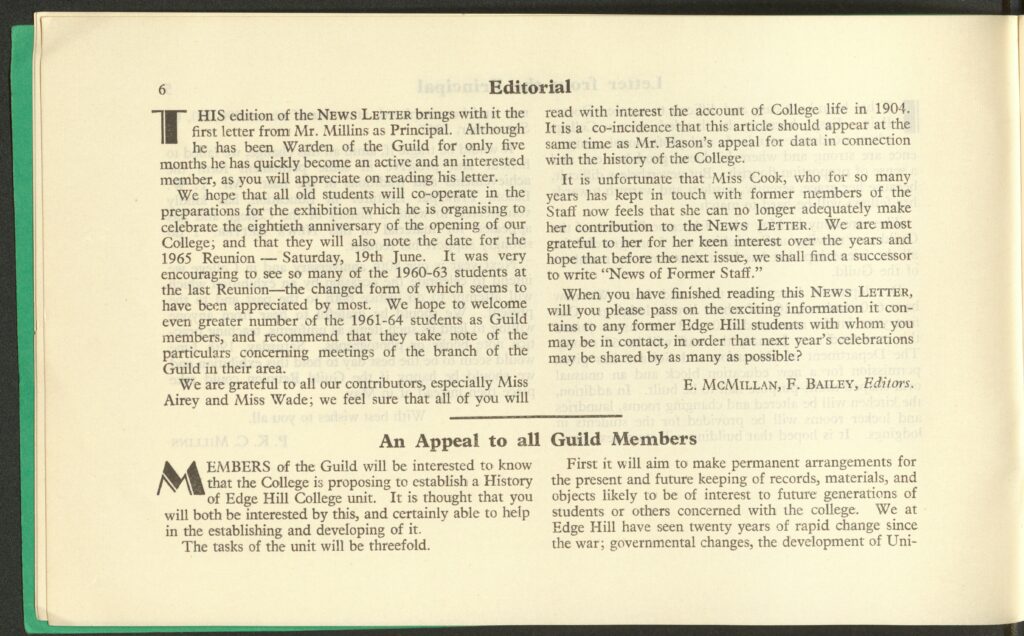
in the 1965 College Magazine – Page 1
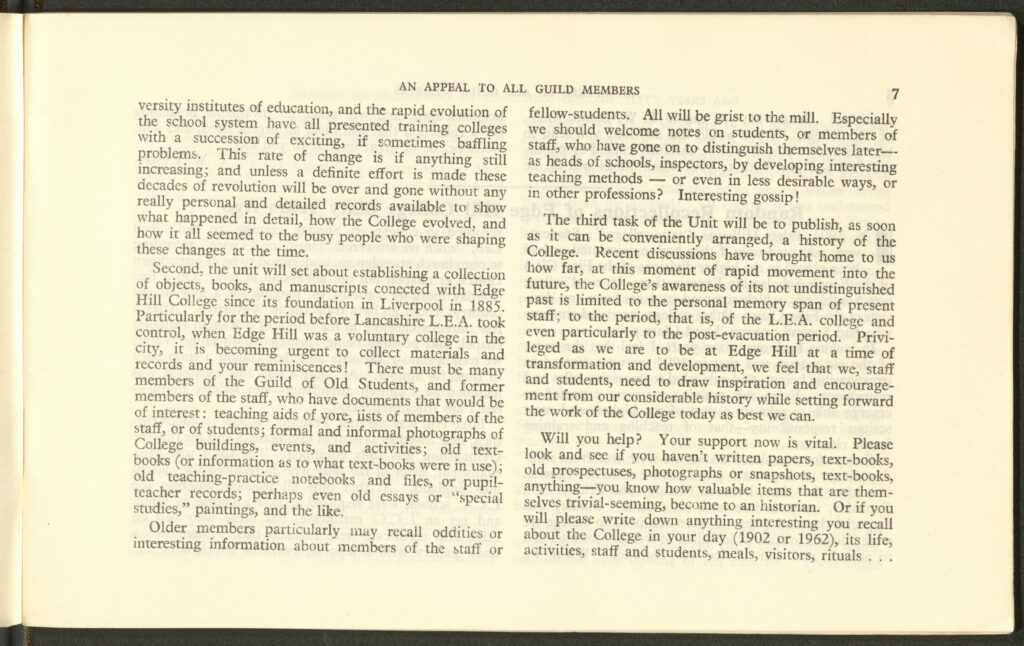
in the 1965 College Magazine – Page 2
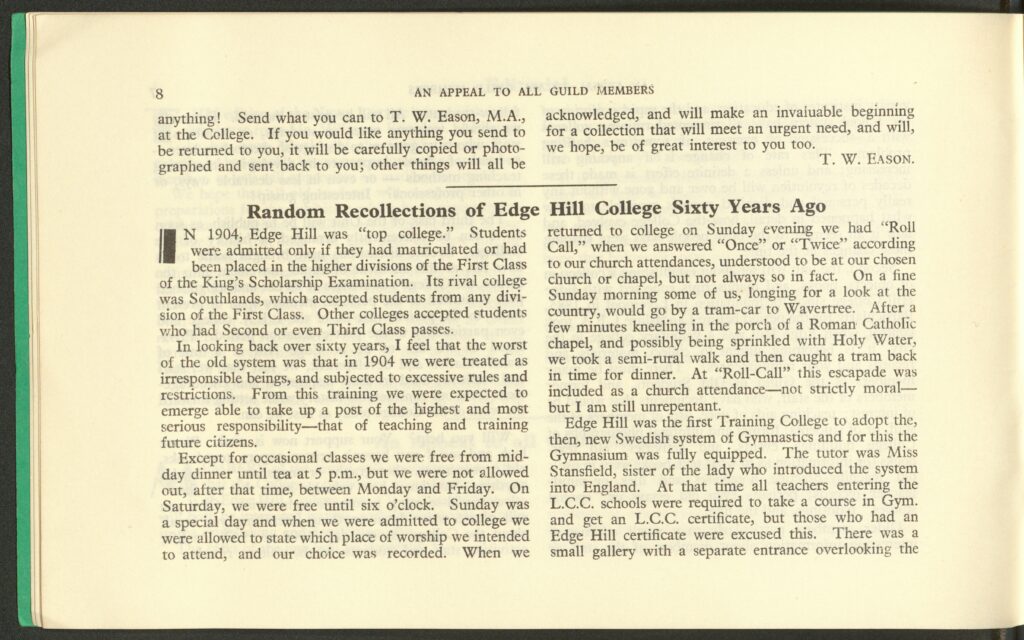
in the 1965 College Magazine – Page 3
The purpose of the unit was threefold: Firstly, ‘to make permanent arrangements for the present and future keeping of records, materials, and objects likely to be of interest to future generations of students or others concerned with the college’, secondly, to establish ‘a collection of objects, books, and manuscripts [connected] with Edge Hill College since its foundation in Liverpool in 1885’, and thirdly, ‘to publish, as soon as it can be conveniently arranged, a history of the College.’
We theorised that Mr. Eason may have published a book about Edge Hill’s history that included some stories from the letters, but no such book has been found. We have, however, discovered an article by Mr. Eason in an issue of the ‘Edge’ magazine that, according to him, ‘is not a history of the college, which remains to be written and is in preparation; it is no more than a few reflections inspired by that history.’
One of my first roles in the archive was to research the first 25 years of early Edge Hill students (1885-1909). It was – and, with the project being unfinished, is – a joy to uncover the lives and stories of the hundreds of students I was researching. So, this section of Mr. Eason’s article resonated with me and my research in the archive:
“Have you ever looked at a nephew, friend, your husband or wife, and thought, ‘How little I really know about you’? All historical research is an exploration of a dark continent, of which the bare outline may be known, a few settlements and river courses, and no more; and this is none the less true when the object of enquiry is so familiar a figure in our lives, so strong a centre of our affections as is the college in which we have worked and lived.”

Part III: K.W. Wild
Not to pick favourites, but a letter signed off by ‘K. W. Wild’ soon stood out from the rest. Katherine Winifred Wild, student at Edge Hill Teacher Training college (1907-10), wrote many insightful anecdotes about her time at College, as well as some about her time after.
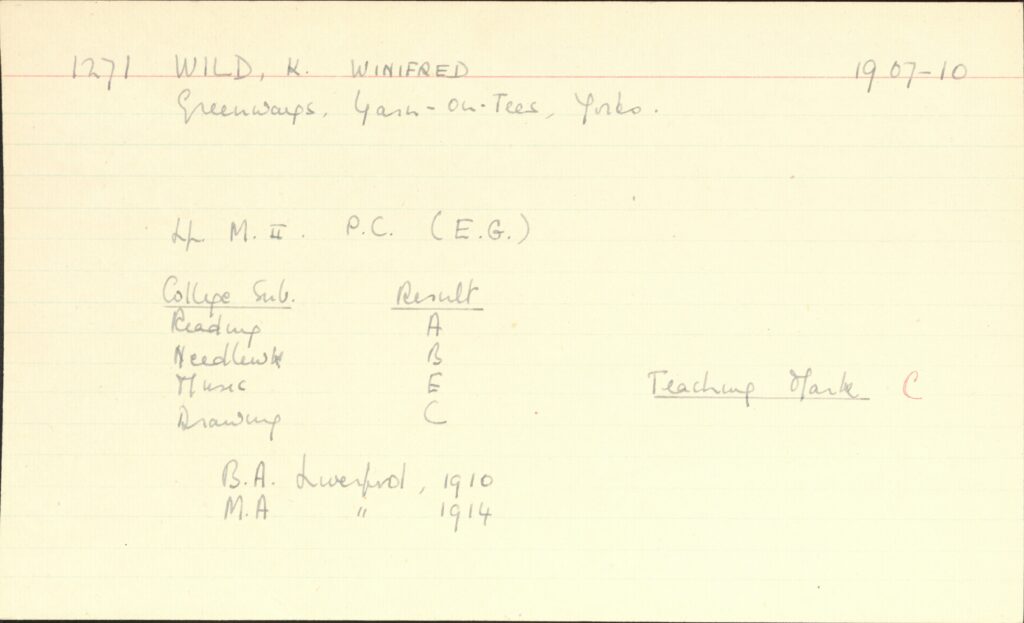
![The first page of a letter written in blue ink. In the top corner there is red ink in different handwriting that says '3 year student' and then in pencil next to this 1907-10 is written in a circle. The letter says:
Greenways
Bank
Eaglescliffe
Co. Durham
7.1.65
Dear Sir (or Madam?), As one of the older members of the Guild of Old Students (1907-10) I am responding to your call for reminiscences. 1st a snap of Miss Hale, very like her, but failing to show, as no snap could, her wonderful eyes.
Second, some notes on the ridiculous on my college life. The most absurd rule I can remember was that, though we each had a tiny private cubicle, we weren’t allowed to use it for study. One of the jobs of the staff on duty was to go poking round & hustle off ant ardent but erring reader. I was, too, frequently turned out of the very pleasant library. The idea seemed to be to keep us on the [word can't be deciphered],
In those days the staff was called ‘governess’](https://blogs.edgehill.ac.uk/ls/files/2023/11/Katherines-Letter-799x1024.jpeg)
Miss. Sarah Hale, head mistress during Katherine’s time at the college, must have had a positive impression of her, as Katherine says ‘[included is] a snap of Miss Hale, very like her, but failing to show, as no snap could, her wonderful eyes.’ Unfortunately, any additional slips of photographs included in these letters weren’t found with their respective letters during the stocktake; they may be in the archive or misplaced at some point, it’s still a mystery to us.
Regarding another member of staff, Miss. ‘Dolly’ Dewhurst, renowned for her strictness (though, according to Katherine, ‘she did have a heart’!), she discusses her escapades with spelling:
“Dolly’s method of correction was to allot a mark out of 20 & take off me for every spelling mistake, & I left her in the awkward predicament of having to record a minus mark.”
However, despite her apparent spelling struggles, Katherine then goes on to say:
‘[…] later, I took a 1st Hons. in Philosophy at London and C. U. Press published a book of mine, I never could spell.’
And we have recently acquired Katherine’s book for the archive, as shown here, a first edition from 1938!
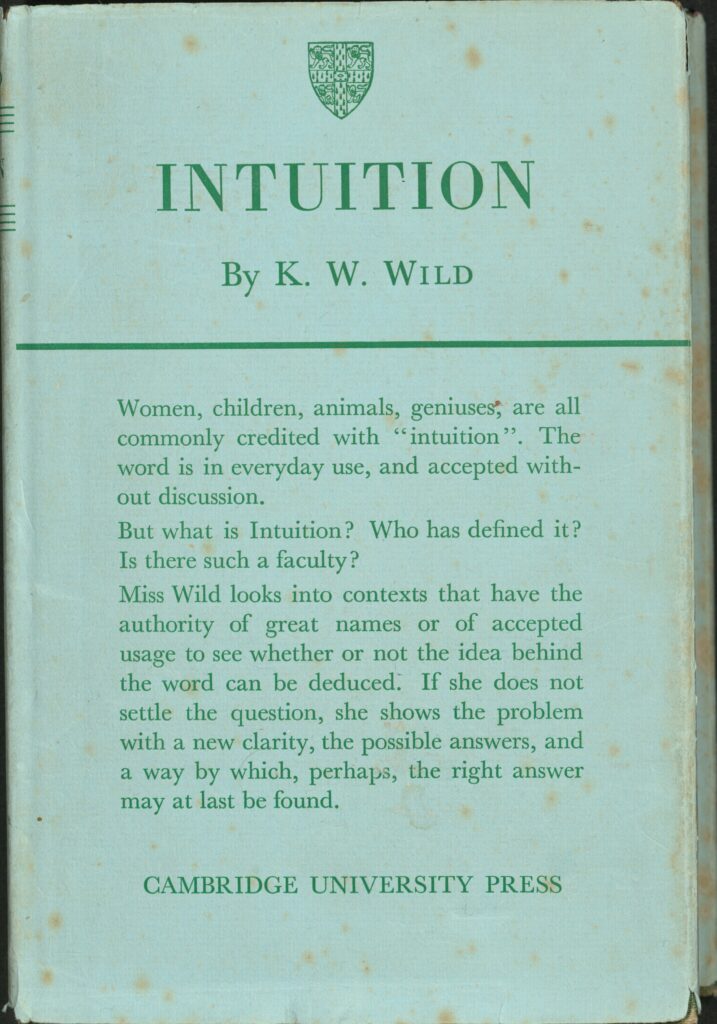
Katherine’s book is still being printed today and sold by major book retailers such as Waterstones and WH Smith. Certain online reviews about ‘Intuition’ comment on how relevant it still is, given it was written in the 1930s.
Following some extensive research using various online and in-archive sources about Katherine, I have been able to build up a chronology of her life. Here is the current timeline of the major life events for Katherine:
1888 – Born between April to June (no fixed date has been found yet) in 1888, Lancashire.
1907 – In the Martriculation Results section of the Manchester Courier, she is listed as attending Clarence Street College, Liverpool.
1907-10 – Attends Edge Hill Teacher Training College on Durning Road, Liverpool. Her index card tells us she leaves with a teaching mark of C.
1910 – Attains B.A. (first-class honours) in Philosophy in London. In Katherine’s letter, she says, ‘Miss Hale had read Moral Philosophy at Cambridge & psychology was well on its way’. We have theorised Miss Hale’s impression on Katherine in philosophy. We can assume this degree was the foundation for her publication in 1938.
1910-12 – Assistant Mistress at Liverpool Education Committee.
1912-15 – Assistant Mistress at Rice Lane Council School, Liverpool.
1914 – Attains an M.A. in Liverpool.
1917-19 – English Mistress at County School, Aberaeron, Ceridigion.
1919-? – Senior English Mistress at Secondary School for Girls, Stockton-on-Tees.
1938 (Feb 16th) – Appears in Liverpool Daily post promoting her book, ‘Intuition’.
1938 (May 16th) – Mentioned in The Scotsman under ‘INTUITION, Emotions and their Regions of Influence’, a review of her book. The reviewer (unnamed) states: ‘Miss Wild’s is in every way a good book, a work of much distinction, particularly well written, dealing with an elusive subject prudently [and] tactfully […]’
1938 – Publishes ‘Intuition’ with Cambridge University Press.
1939 – Living with Florence Sweetinburgh, both of whom are unmarried and Secondary School Mistresses, in Egglescliffe, Durham.
1965 – Writes letter to Mr. Eason regarding her college memories following his call out in the College Magazine.
1970 (Apr 23rd) – Dies in lorry collision with three other women including Florence Sweetinburgh, Florence’s sister Evelyn, and Muriel Whitehouse. The Hull Daily Mail on Friday 24 April 1970 had a column about the collision.
Katherine is the student I chose to celebrate and spotlight in this blog because she’s the only one (as of yet) we’ve done extensive research on. One of the most exciting parts of the discovery of these letters (and the Archive in general!) is the research to do and the questions to answer.

Do you want to know more?
All records included as images in this blog can be seen at the Edge Hill Archive in Catalyst.
If you would like to book an appointment at the archive, donate anything, or share stories (I’m sounding like Mr. Eason, aren’t I?), don’t hesitate to contact us!
By Jack Bennett, Archive Assistant
Learn more about the archive
To find out more about our archive you can visit their webpage or browse their collections online.
